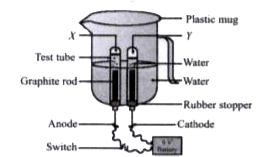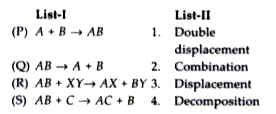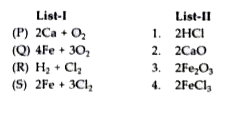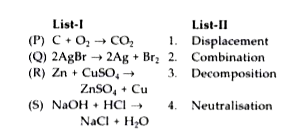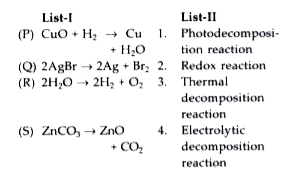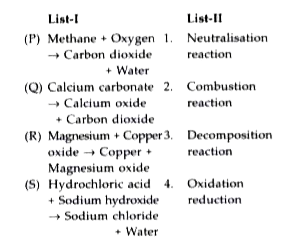EXERCISE (COMPREHENSION TYPE) from MTG IIT JEE FOUNDATION CHEMICAL REACTIONS AND EQUATIONS for Class 10
| Class 10 | CHEMISTRY |
| Chapter | CHEMICAL REACTIONS AND EQUATIONS |
| MTG IIT JEE FOUNDATION | EXERCISE (COMPREHENSION TYPE) |
| Medium | English |
| Academic Year | 2023-2024 |
Question 27
Barium chloride on reacting with ammonium sulphate forms barium sulphate and ammonium chloride. Which of the following correctly represents the type of the reaction involved?
(i) Displacement reaction
(ii) Precipitation reaction
(iii) Combination reaction
(iv) Double displacement reactionView SolutionQuestion 44
Three beakers labelled as A, B and C each containing 25 mL of water were taken. A small amount of NaOH, anhydrous CuSO4 and NaCl were added to the beakers A, B and C respectively. It was observed that there was an increase in the temperature of the solutions contained in beakers A and B, whereas in case of beaker C, the temperature of the solution falls. Which one of the followig statement (s) is (are) correct?
1. In beakers A and B, exothermic process has occurred.
2. In beakers A and B, endothermic process has occurred.
3. In beaker C, exothermic process has occurred.
4. In beaker C, endothermic process has occurred.View SolutionQuestion 66
Oxidation and reduction always occur simultaneously. These reactions which involve simultaneous oxidation and reduction are called redox reactions. Therefore, every redox reaction is made up of two half reactions. One half reaction represents oxidation and other half reaction represents the reduction. Oxidation and reduction of an atom, molecule or ion can also be defined in terms of electrons. The substance that gains electrons, is reduced to a lower oxidation state and acts as an oxidising agent. Similarly, the substance which loses electrons is oxidised to a higher oxidation state, and is called a reducing agent.
In which of the following reactions hydrogen peroxide is acting as a reducing agent?View SolutionQuestion 67
Oxidation and reduction always occur simultaneously. These reactions which involve simultaneous oxidation and reduction are called redox reactions. Therefore, every redox reaction is made up of two half reactions. One half reaction represents oxidation and other half reaction represents the reduction. Oxidation and reduction of an atom, molecule or ion can also be defined in terms of electrons. The substance that gains electrons, is reduced to a lower oxidation state and acts as an oxidising agent. Similarly, the substance which loses electrons is oxidised to a higher oxidation state, and is called a reducing agent.
The reaction : H2S+H2O2→S+2H2O indicatesView SolutionQuestion 68
Oxidation and reduction always occur simultaneously. These reactions which involve simultaneous oxidation and reduction are called redox reactions. Therefore, every redox reaction is made up of two half reactions. One half reaction represents oxidation and other half reaction represents the reduction. Oxidation and reduction of an atom, molecule or ion can also be defined in terms of electrons. The substance that gains electrons, is reduced to a lower oxidation state and acts as an oxidising agent. Similarly, the substance which loses electrons is oxidised to a higher oxidation state, and is called a reducing agent.
In acidic medium, Mn7+ changes to Mn2+, it isView SolutionQuestion 71
Oxygen is prepared by catalytic decomposition of potassium chlorate (KClO3). Decomposition of potassium chlorate gives potassium chloride (KCl) and oxygen (O2). The following reaction takes place : 2KClO3(s)→2KCl(s)+3O2(g).
How many grams of KClO3 are required to produce 128 grams of O2? [At. mass of O = 16 u, K = 39 u, Cl = 35.5 u]View SolutionQuestion 93
In the following situations, a reaction may or may not take place. If it does, write the balanced molecular, total ionic and net ionic equations illustrating the reaction. Assume all the reactions take place in aqueous solutions.
Some iron nails are placed in a CuCl2 solution.View SolutionQuestion 94
In the following situations, a reaction may or may not take place. If it does, write the balanced molecular, total ionic and net ionic equations illustrating the reaction. Assume all the reactions take place in aqueous solutions.
Silver coins are dropped in hydrochloric acid solution.View SolutionQuestion 95
In the following situations, a reaction may or may not take place. If it does, write the balanced molecular, total ionic and net ionic equations illustrating the reaction. Assume all the reactions take place in aqueous solutions.
A copper wire is placed in Pb(NO3)2 solution. View SolutionQuestion 118
You are given the following materials :
(i)Iron nails(ii)Copper sulphate solution(iii)Barium chloride solution(iv)Copper powder(v)Ferrous sulphate crystals(vi)Quick lime
Identify the type of chemical reaction taking place when :
(a) Barium chloride solution is mixed with copper sulphate solution and a white precipitate is observed.
(b) On heating, copper powder in air in a china dish, the surface of copper powder becomes black.
(c) On heating green ferrous sulphate crystals, reddish brown solid is left and a gas having smell of burning sulphur is noticed.
(d) Iron nails when left dipped in blue copper sulphate solution becomes brownish in colour and blue colour of copper sulphate solution fades away.View SolutionQuestion 119
You are given the following materials :
(i)Iron nails(ii)Copper sulphate solution(iii)Barium chloride solution(iv)Copper powder(v)Ferrous sulphate crystals(vi)Quick lime
Identify the type of chemical reaction taking place when :
(a) Barium chloride solution is mixed with copper sulphate solution and a white precipitate is observed.
(b) On heating, copper powder in air in a china dish, the surface of copper powder becomes black.
(c) On heating green ferrous sulphate crystals, reddish brown solid is left and a gas having smell of burning sulphur is noticed.
(d) Iron nails when left dipped in blue copper sulphate solution becomes brownish in colour and blue colour of copper sulphate solution fades away.View SolutionQuestion 120
You are given the following materials :
(i)Iron nails(ii)Copper sulphate solution(iii)Barium chloride solution(iv)Copper powder(v)Ferrous sulphate crystals(vi)Quick lime
Identify the type of chemical reaction taking place when :
(a) Barium chloride solution is mixed with copper sulphate solution and a white precipitate is observed.
(b) On heating, copper powder in air in a china dish, the surface of copper powder becomes black.
(c) On heating green ferrous sulphate crystals, reddish brown solid is left and a gas having smell of burning sulphur is noticed.
(d) Iron nails when left dipped in blue copper sulphate solution becomes brownish in colour and blue colour of copper sulphate solution fades away.View SolutionQuestion 121
You are given the following materials :
(i)Iron nails(ii)Copper sulphate solution(iii)Barium chloride solution(iv)Copper powder(v)Ferrous sulphate crystals(vi)Quick lime
Identify the type of chemical reaction taking place when :
(a) Barium chloride solution is mixed with copper sulphate solution and a white precipitate is observed.
(b) On heating, copper powder in air in a china dish, the surface of copper powder becomes black.
(c) On heating green ferrous sulphate crystals, reddish brown solid is left and a gas having smell of burning sulphur is noticed.
(d) Iron nails when left dipped in blue copper sulphate solution becomes brownish in colour and blue colour of copper sulphate solution fades away.View SolutionQuestion 122
You are given the following materials:
(i) Iron nails
(ii) Copper sulphate solution
(iii) Barium chloride solution
(iv) Copper powder
(v) Ferrous sulphate crystals
(vi) Quick lime
Identify the type of chemical reaction taking place when :
Quick lime reacts vigorously with water releasing a large amount of heat.View Solution
All Exercises from MTG IIT JEE FOUNDATION Class 10 CHEMISTRY CHEMICAL REACTIONS AND EQUATIONS
- NCERT SECTION
- EXERCISE (ASSERTION & REASON TYPE)
- EXERCISE (COMPREHENSION TYPE)
- EXERCISE (INTEGER/NUMERICAL VALUE TYPE)
- EXERCISE (LONG ANSWER TYPE)
- EXERCISE (MATCH THE FOLLOWING)
- EXERCISE (MULTIPLE CHOICE QUESTIONS) (LEVEL-1)
- EXERCISE (MULTIPLE CHOICE QUESTIONS) (LEVEL-2)
- EXERCISE (SHORT ANSWER TYPE)
- EXERCISE (VERY SHORT ANSWER TYPE)
- OLYMPIAD/HOTS CORNER
- ILLUSTRATIONS
- SOLVED EXAMPLES

